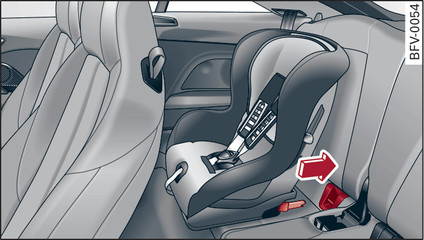|
|
Applies to AudiTTs: with ISOFIX
Child seats of the categories 0, 0+ and 1 with ISOFIX can be secured without a seat belt using the ISOFIX anchorages on the rear seats and on the front passenger s seat*.
Push the mountings on the child seat into the ISOFIX anchorages until they engage audibly Fig. 187►.
Pull on the child seat to check whether both sides have engaged properly.
If you wish to attach an ISOFIX child seat to the ISOFIX anchorages in your AudiTT, please ensure that it is approved for the seats in your AudiTT. The following table link► shows the installation options. The necessary information can be found on the orange label on the child seat.
An ISOFIX child seat categorised as “AudiTT-specific”, “restricted” or “semi-universal” (IL) is suitable for a seat if:
- your AudiTT is listed in the model list provided by the child seat manufacturer and
- your child seat is marked with IL in the following table.
An ISOFIX child seat categorised as “universal”, (IUF) is suitable for a seat if:
- your child seat is marked with IUF in the following table and
- the child seat can be secured with top tether1) link►.
Weight class | ISOFIX size category | Outer rear seats | Front passenger s seat1) |
|
Category 0: up to 10 kg | E | IL | IL |
Category 0+: up to 13 kg | E | IL | IL |
D | |||
C | |||
Category 1: 9 to 18 kg | D | IL IUF2) | IL |
C | |||
B | |||
B1 | |||
A | |||
|
Category 2/3: 15 to 36 kg | -
|
x
|
IL3) |
- Never install a rearward-facing child seat on the front passenger s seat unless the front passenger s airbag has been deactivated – this can result in potentially fatal injuries to the child.
- The anchorages in the AudiTT are designed only for child seats with ISOFIX. Do not attempt to secure other types of child seat, seat belts or other objects to these anchorages - this could result in serious or possibly fatal injury.

